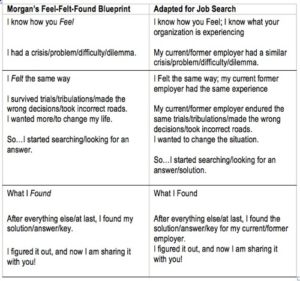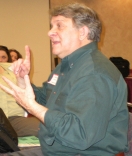Recent encounters have provided me with new ideas about how to structure stories in the job search. As I sold copies of my book, Tell Me About Yourself, at the recent conference of the Career Management Alliance, career practitioners told me they recognized the value in job-seekers telling stories but that it’s hard for them to come up with ways to structure their stories. My book offers a number of structures, but I’m always looking for even more ways that job-seekers can build cohesive stories.
It’s always easiest to think about using these structures in stories that respond to job-interview questions. They can be used in resumes, cover letters, and other aspects of the job search, but doing so is trickier in those contexts, so let’s first apply them to interviewing.
- In a much-retweeted blog entry Lesley Morgan wrote about a Storytelling Blueprint that she calls “a simplified outline of well-known mythologist Joseph Campbell’s the Hero’s Journey.”Morgan has titled this structure the Feel … Felt … Found Blueprint. In the table below, Morgan’s blueprint appears in the left column while a suggested adaptation for the job search is in the right column:
 How might you bring up a story like this? An effective approach would be to introduce this story during the phase of the interview when you are asking the interviewer questions. Ask a question such as, “What’s the greatest challenge your organization faces?” If you have a story about handling a similar challenge in a current or past job, you can use the Feel-Felt-Found Blueprint to structure your narrative.
How might you bring up a story like this? An effective approach would be to introduce this story during the phase of the interview when you are asking the interviewer questions. Ask a question such as, “What’s the greatest challenge your organization faces?” If you have a story about handling a similar challenge in a current or past job, you can use the Feel-Felt-Found Blueprint to structure your narrative.Would you really say to the interviewer, “I know how you feel?” Possibly. Take your cue from the emotional content of the interviewer’s story. For example, if the interviewer says the organization’s challenge sapped the morale of its employees, it might be appropriate to say, “I know how they felt.” If the challenge the interviewer describes lacks emotional content, you can simply skip the “feel/felt” words and say “I know what your organization is experiencing.” Then tell the story of how you handled an analogous situation.
- At last month’s Golden Fleece Conference, Gerry Lantz talked about using the question “What’s at stake?” to think about story structure.In a job interview, use this question to build details of your story. As
 you are describing a problem you solved for a current or past employer, tell what was at stake — what would have happened if you hadn’t solved the problem.
you are describing a problem you solved for a current or past employer, tell what was at stake — what would have happened if you hadn’t solved the problem.
Here’s an example, a response to a question about how well the interviewee handles pressure, that truly shows what was at stake — the life of a person. If the candidate could handle pressure when the stakes are that high, he or she could likely handle in the job he or he was interviewing for:
My past experience as an administrative coordinator required me to deal with many serious situations since I held emergency on-call duties as a supervisor. One example was when I was called by a resident assistant to deal with an attempted suicide on her residence-hall floor. The situation required that I think clearly and quickly in this life-and-death situation. I had to weigh the many tasks that needed to be completed. I had to assign RAs to call 911, make sure the paramedics could get into the locked building, while at the same time applying first aid, and ensuring that the rest of the residents on the floor were OK. I also had to make sure the privacy of the resident in need was respected. I basically prioritized and dealt with each task by its importance. I delegated responsibility to RAs for things that they were capable of handling because I could not physically be in many places at once. Once the resident was taken to the hospital, I handled the paperwork and followed up to make sure the staff members, residents, and the resident in need adjusted back to “normal” life. I know this is an extreme example not found in the financial consulting field; however, it shows just how well I can deal with tremendous pressure.
- At the Career Management Alliance conference I just attended, I had the pleasure of hearing — for the second time — screenwriter Bill True of Minneapolis-based Sage Presence. The story-based aspects of True’s interview recommendations are not exactly new, but he frames and presents them in a fresh way.
 Part of the Sage Presence approach is that interviewees should tell stories that demonstrate how they were the catalyst for beneficial change. Otherwise, when searching their brains for interview responses, they will likely get lost in the sea of information that could be brought up in an interview.
Part of the Sage Presence approach is that interviewees should tell stories that demonstrate how they were the catalyst for beneficial change. Otherwise, when searching their brains for interview responses, they will likely get lost in the sea of information that could be brought up in an interview.
The structure that Sage presence recommends for stories to tell in interview is one in which actions occur that take people from a negative situation to a positive one. Then, the interviewee must identify the changes that he or she facilitated that illustrate benefits to the prospective employer. “The job-seeker’s past experience is today’s value,” True said.
True also suggests thinking of your interview persona (and perhaps responses to individual interview questions) in terms of movie titles: “[name of interviewee] brings [description of benefit].”
